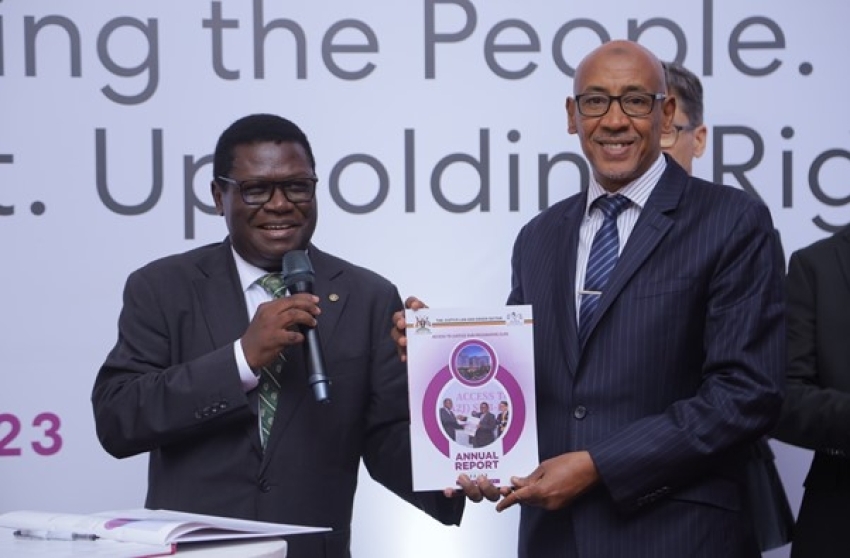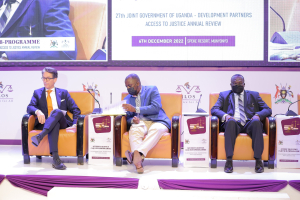Access to Justice (JLOS) Sub-programme performance report (FY 2022/23): Key Facts and Figures
December 01, 2023
1402
 Hon. Nobert Mao, the Minister of Justice and Constitutonal Affairs (left) at the launch of the Access to Justice (JLOS) Annual Performance Report (2022/23) in Kampala
JLOS Media
Hon. Nobert Mao, the Minister of Justice and Constitutonal Affairs (left) at the launch of the Access to Justice (JLOS) Annual Performance Report (2022/23) in Kampala
JLOS Media
DOWNLOAD 2022/23 ANNUAL JLOS REPORT
- At the impact level, public trust in the justice system remains high compared to the SDPIV end-term evaluation and efforts to maintain it at higher levels are under implementation including addressing lead times for delivery of services, opening more service points, ensuring certainty in service delivery, and making use of online services.
- The sub-programme invested in the construction of justice centers increasing the number of districts with one-stop frontline JLOS points from 90 to 92 out of the targeted 117 districts.
- The Construction of the JLOS house phase one launched on 10th June 2022 is now over 60% and is expected to be completed in 2024.
- The sub-programme registered an increased disposal of cases from 52% in 2020 to 63% resulting in a 10% reduction in the proportion of backlog. Also, a 72% conviction rate was registered due to improved investigations and strong coordination. While the proportion of pretrial detained reduced to 48%
- The continued use of correctional approaches in the rehabilitation of inmates led to a 20% reduction in the rate of re-offending to 13.9% compared to the baseline of 17.2% in FY 2017/18.
- Public trust in the justice system is 69% according to data collected from the SEMA pilot program located at 50 frontline JLOS service points. Average satisfaction levels as measured by the SEMA applications at selected JLOS service points stand at 70%.
- During the reporting period, Pre-trial detainees reduced from 50.8% at the beginning of the financial year, to 48.5%. This is attributed to increased disposal of cases by the Judiciary, from 55% in FY 2021/22 to 63% in FY 2022/23. In addition, increased use of non-custodial punishment such as community service has reduced the inflow of convicted persons into prisons. For instance, the MIA was able to supervise a total number of 14,595 Community Service Orders (13,505 male, 1090 female) against an annual target of 14,000 orders representing 104.25%. Convicts sentenced to community service increased from 67.8% to 70% in the reporting period. However, the crime rate increased from 457.94 in FY 2021/22 to 524 in FY 2022/23 per 100,000 population.
- The CCTV surveillance project has revolutionized crime response and prevention with the system being operational (Phase II) in 71 districts, 10 cities, 20 municipalities, 35 towns, 06 border points and all major highways. The use of the Automated fingerprint Information system (AFIS) also helped to identify 3266 repeat offenders, while 219 people with criminal records seeking certificates of good conduct were identified.
- The plea bargain approach enabled the ODPP to deal with case backlog by fast-tracking cases, resulting in reduced case disposal time. It also improved the conviction rates since it offers 100% conviction rates.
- A total of 41 legal aid clinics run by JCU, ULS and LDC are fully operational and supported by JLOS. Those reached out to 141,347 vulnerable individuals and communities.
- Automation of Case management systems is ongoing in many institutions including the Judiciary, Uganda Registration Services Bureau (URSB), Directorate for Citizenship and Immigration Control (DCIC), National Identification and Registration Authority (NIRA), Office of the Director of Public Prosecutions (ODPP) and Judiciary. Other key areas of focus are streamlining processes, strengthening records management and reforming civil and business registries.
- The ODPP rolled out the Prosecution Case Management Information System (PROCAMIS) although it was slower than planned. The system has coverage of 42 (30%) out of 136 offices. The scope of automation covers headquarters, regional offices, and field stations.
- With regards to national identification and registration, which is a key driver for the improvement of service delivery in the country, cumulatively, a total of 16,749,675 cards have been issued to eligible citizens out of 19,761,668 cards printed.
- With regards to immigration, 12,354 work permits, 6,888 dependent passes, and 12,786 foreign students were facilitated. In addition, 7,030 people were granted special passes, 238,986 entry visas were issued, and 8,154 sought visitor pass extensions.
- During the reporting period, Anti-Corruption Agencies registered major progress in strengthening transparency, accountability, and anti-corruption systems. Conviction rates of corruption cases increased from 74% in 2017/18 to 82% in the reporting period due to the use of prosecution let investigation while the clearance rate of cases increased from 98% to 110% in the review period. This was because of the use of the interagency forum and stronger coordination and collaboration of the agencies involved in the fifth against crime.
- UHRC carried out inspections in 163 detention facilities including 86 Police stations, 31 Prisons, 41 Police posts, 3 remand homes and 2 military detention facilities. There were noticed improvements in living conditions, however, congestion remains an eye soar. To address this challenge, UPS constructed four (4) wards that increased the holding/ sleeping capacity from 19,986 prisoners (71,949.6M2) to 20,321 prisoners (73,155.6M2).
- The National Action Plan for Business and Human Rights is being implemented to mainstream human rights norms in the private sector. In addition, MoJCA mainstreamed the accepted recommendations from the third Universal Periodic Review into the National Action Plan for Human Rights (NAP). The NAP articulates human rights priority actions and interventions for implementation by both State and non-state actors.
- The program enhanced compliance with the bill of Rights, with the Uganda Human Rights Commission (UHRC) continuing to maintain an international ‘A’ status. UHRC conducted Tribunals across the nine (9) Regional offices. As a result, a total number of 143 matters were handled by the tribunal and complaints 93 (32 Male, 61 female) were resolved through mediation.
Challenges in the reporting period:
- The low staff numbers across the sub-programme institutions. Failure to address staffing has far-reaching implications and may reverse the gains made so far. This is made worse by the disproportionate recruitment in the judiciary as compared to other JLOS institutions.
- Increased prisoner population and Congestion in Prisons that exceeds carrying capacity by more than double. This may be addressed partly through expanding carrying capacity and crime prevention measures, in addition to focusing on alternative modes of punishment away from traditional incarceration. The increasing prison population puts pressure on housing, sanitation, medicare, feeding, uniforms, staff numbers and delivery of prisoners to courts.
- Inadequate facilitation of Attorneys and witnesses, affects the ability of the Government to be effectively represented in the courts of law for local and international cases.
NEWSROOM
Latest News
Privacy Policy
News Archives





